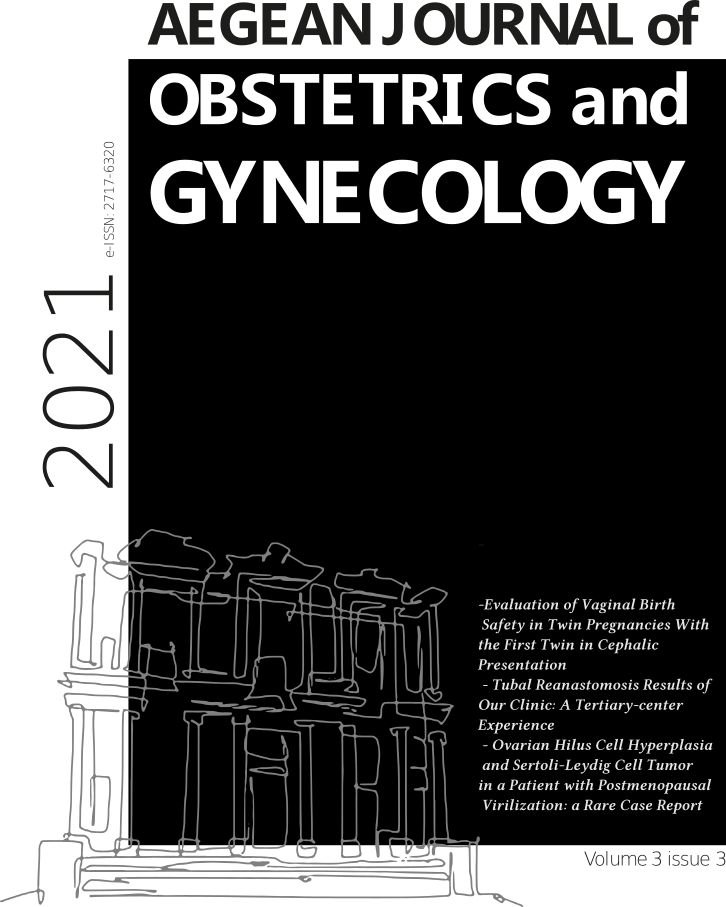The importance of maternal ischemia modified albumin, non stress test and doppler ultrasonography in foreseeing perinatal asphyxia
Ischemia modified albumin in foreseeing perinatal asphyxıa
DOI:
https://doi.org/10.46328/aejog.v3i3.98Keywords:
ischemia, fetal asphyxia, preeclampsia, non stress test, doppler ultrasonographyAbstract
Background: The aim of this study is to evaluate the importance of ischemia changed albumin, in foreseeing fetal asphyxia and comparing it between normal and preeclamptic pregnant.
Method: We planned our study as a prospective case-controlled study between May 2011 and June 2013. We recruited 104 pregnant women complicated by preeclampsia and 110 healthy pregnant women in the study. Doppler ultrasonography, non-stress test and fetal biometric measurements were performed. Venous blood samples taken to measure ischemia modified albumin (IMA). The presence of fetal hypoxia/acidosis was analyzed by conducting post-natal cord blood gas examination and 1.-5. minutes APGAR scoring.
Results: Women with preeclampsia had higher IMA compared to controls. The correlations between umbilical artery doppler systolic/diastolic (S/D) ratio, brain sparing effect, non stress test and IMA analyzed. We have found IMA statistically high when S/D ratio is above 2 standard deviations (preeclampsia; 11.83±1.33 vs 19.62±1.56 p<0.001, control; 10.28±1.57 vs 18.09±2.13 p<0.001) or brain sparing effect started (preeclampsia; 25.59±2.48 vs 9.16±1.99 p<0.001, control; 16.37±1.97 vs 6.72± 1.53 p<0.001) or abnormal NST findings occurred (preeclampsia; 10.69±1.92 vs 20.72±1.15 p<0.001, control; 7,42±1,94 vs 9,72±2,19 p<0.001).
Conclusions: Maternal IMA levels are found high in preeclamptic pregnant women and it can be used as a biomarker for determining fetal wellbeing.
Downloads
Published
Issue
Section
License
Copyright (c) 2021 Ferruh Acet, Volkan Emirdar; Murat Celiloğlu; Merve Akış, Gül İşlekel

This work is licensed under a Creative Commons Attribution-NonCommercial 4.0 International License.
AEJOG is an open-access journal which means that through the internet; freely accessible, readable, downloaded, copied, distributed, printed, scanned, linked to full texts, indexed, transferred to the software as data and used for any legal purpose, without financial, legal and technical obstacles. The only authority on reproduction and distribution and the sole copyright role in this field; has been given to authors therefore they can have control over the integrity of their work, so that they are properly recognized and cited. This is in accordance with the BOAI definition of open access.
The content in Aegean Journal of Obstetrics and Gynecology (AEJOG) is protected by copyright. All copyrights of the submitted articles are transferred to the Aegean Journal of Obstetrics and Gynecology within the national and international regulations at the beginning of the evaluation process. Upon submission of their article, authors are requested to complete an assignment of copyright release form. Authors should acknowledge that they will not submit their manuscript to another journal, publish in any other language, or allow a third party to use the article without the written consent of the Aegean Journal of Obstetrics and Gynecology. When an article is published on AEJOG, it is read and reused for free as soon as it is published under a Creative Commons Attribution-NonCommercial 4.0 (CC BY NC 4.0) license. In case the article is rejected, all copyrights are given back to the authors.
The content of the article and all legal proceedings against the journal, if any, are the responsibility of the author. In addition, all financial and legal liability for the copyright of the presented tables, figures and other visual materials protected by law belongs to the authors. It is the responsibility of the corresponding author to report authors scientific contributions and responsibilities regarding the article. In case of any conflict of interest, it is the responsibility of the authors to indicate the conflict of interest in the Disclosure part of the article. Author names will be published as they are listed on the submitted Title page.




